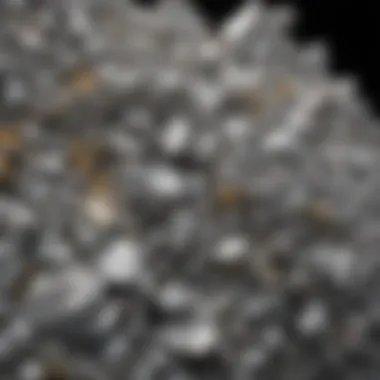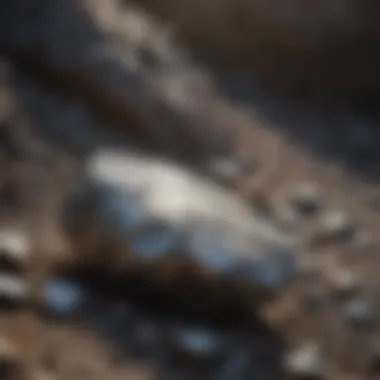Unraveling the Intricacies of Silver Ore's Market Value: A Comprehensive Guide


Rock and Fossil Identification
The evaluation of silver ore involves an in-depth analysis of its composition and market dynamics. To comprehend the worth of silver ore effectively, one must delve into the characteristics and variables that influence its market value. Understanding the nature of silver ore is crucial for determining its intrinsic value and recognizing the factors that drive its pricing fluctuations.
Silver ore can vary in composition, with different ores containing varying concentrations of silver along with other minerals and elements. Examining these compositions is essential for assessing the quality and potential worth of a particular ore specimen. By identifying and understanding the components present in silver ore, collectors and traders can make informed decisions regarding its value and market viability.
When looking at silver ore, specific features such as color, texture, and mineral content play a significant role in determining its value. Experienced collectors and geologists often utilize specialized tools to aid in the identification process, such as magnifying glasses, UV lights, and chemical testing kits. These tools help in distinguishing between different types of silver ore and assessing the purity of the silver content, which directly influences its market price.
Collecting Tips and Techniques
Collecting silver ore requires a methodical approach to ensure the acquisition of quality specimens. Engaging in best practices for collecting involves conducting research to identify prime collecting sites where high-quality silver ore can be found. By understanding the geological formations that are likely to host silver deposits, collectors can increase their chances of discovering valuable specimens.
Locating prime collecting sites often involves exploring areas with a history of silver mining or known mineral deposits. These locations may include specific types of rock formations or geologically rich areas where silver ore is commonly found. Utilizing geographical maps, geological surveys, and local knowledge can be instrumental in pinpointing optimal locations for collecting silver ore.
When extracting specimens from collecting sites, it is essential to follow safety protocols to prevent accidents and preserve the integrity of the specimens. Tools such as rock hammers, chisels, and safety goggles are vital for safely extracting silver ore from rocks and mineral deposits. By employing proper techniques and equipment, collectors can gather valuable specimens while minimizing environmental impact and personal risk.
Geological Insights
Understanding the geological context of silver ore provides valuable insights into its formation and distribution. Geological formations play a crucial role in the occurrence of silver deposits, with certain rock types and structures being more conducive to the formation of silver-bearing ores. By studying the geological processes that lead to the deposition of silver, collectors can gain a deeper appreciation for the scientific significance of these mineral resources.
The historical significance of silver mining and the exploration of silver deposits date back centuries, with silver being a sought-after precious metal renowned for its monetary value and industrial applications. Notable discoveries of silver ore have shaped the course of history, influencing trade, economy, and technological advancements. Studying these discoveries can offer valuable lessons in geology and mineral exploration, shedding light on the geological forces that have shaped the Earth's mineral resources.
Geological insights into silver ore contribute to a comprehensive understanding of its value and significance in the market. By delving into the geological processes that govern the formation of silver ore deposits, collectors and enthusiasts can enrich their knowledge of this precious metal and appreciate its geological context within the Earth's intricate systems.
Introduction to Silver Ore Valuation
In this section, we delve into the crucial aspects of valuing silver ore. Silver, a precious metal known for its conductivity and luster, plays a significant role in various industries and investment portfolios. Understanding the composition and market dynamics of silver ore is paramount for investors, geologists, and industrial stakeholders seeking to assess its worth accurately. By examining the silver content and the presence of other minerals, we can unravel the intrinsic value of silver ore within the market context.
Composition of Silver Ore
Silver Content


The silver content of ore determines its purity and market value. Silver, characterized by its brilliant white sheen and exceptional conductivity, remains a highly sought-after metal in industrial and investment circles. The purity of silver content in ore influences its price and usability in diverse applications. While high silver content enhances the desirability of ore for refining purposes, lower concentrations may necessitate advanced extraction techniques, impacting operational costs and profitability.
Other Minerals Present
Apart from silver, silver ore may contain varying quantities of other minerals, such as lead, zinc, and copper. These additional minerals can affect the overall composition and processing requirements of the ore. While certain minerals may enhance the properties of silver for specific applications, others could introduce challenges during extraction and refining processes. Balancing the presence of other minerals alongside silver content is crucial in determining the economic viability and utility of silver ore within the market.
Market Factors
Supply and Demand Dynamics
The interplay between supply and demand influences the pricing and availability of silver ore globally. Fluctuations in production volumes and consumer demand directly impact the market value of silver. Understanding the supply chain dynamics, including mining outputs and refining capacities, allows stakeholders to anticipate price trends and make informed decisions regarding silver investments.
Global Economic Conditions
Global economic conditions, such as inflation rates, currency valuations, and geopolitical stability, influence the demand for silver as an investment hedge and industrial commodity. Economic indicators like GDP growth and interest rates can signal shifts in silver prices. By monitoring economic trends and policy developments, stakeholders can position themselves strategically in the silver market.
Industrial Applications
Silver's unique properties, including its conductivity, reflectivity, and antibacterial attributes, render it indispensable in various industries. From electronics manufacturing to healthcare, silver finds widespread applications that sustain its market demand. The evolving industrial landscape and technological advancements continuously reshape the demand for silver, underscoring its enduring relevance in modern production processes.
Valuation Methods
Assay Testing
Assay testing involves sampling and chemically analyzing silver ore to determine its precious metal content accurately. This method provides insight into the purity of silver within ore samples, aiding in pricing and processing decisions. The precision of assay testing ensures reliable valuation assessments, guiding stakeholders in optimizing their extraction and refining operations.
Spot Price Evaluation
Evaluating silver ore against current spot prices in bullion markets is instrumental in assessing its immediate value. Spot price evaluation enables stakeholders to gauge the profitability of silver holdings and anticipate market trends. Tracking price fluctuations and market sentiment helps investors and traders capitalize on favorable trading opportunities.
Mineralogical Analysis
Analyzing the mineralogical composition of silver ore offers detailed insights into its geology and physical properties. Mineralogical analysis aids in identifying ore types, predicting processing challenges, and optimizing extraction methodologies. By leveraging mineralogical data, stakeholders can mitigate operational risks and maximize the value extracted from silver deposits.


Determining the Value
In this segment, we delve into the crucial aspect of determining the worth of silver ore. Understanding the value of silver ore is paramount in making informed decisions regarding its extraction and utilization in various industries. By analyzing key components such as assay testing results and spot price evaluation, stakeholders can grasp the intrinsic value that silver ore holds in the market. It plays a significant role in shaping investment strategies and forecasting future market trends.
Assay Testing Process
Sampling Techniques
Sampling techniques serve as the foundation for accurate assay testing of silver ore. These techniques involve meticulously collecting representative samples from various locations within the ore body to ensure a comprehensive analysis. The chosen sampling method significantly impacts the accuracy of the assay results, making it a critical step in determining the true value of the ore. Proper sampling techniques help in minimizing errors and deviations, thus enhancing the reliability of the overall assessment.
Chemical Analysis Procedures
Chemical analysis procedures entail a meticulous examination of the sampled materials to determine the exact composition of silver ore. Through sophisticated analytical techniques, such as spectroscopy and chromatography, experts can identify the silver content and presence of other minerals with precision. This detailed analysis provides crucial data for calculating the economic viability of extracting silver from the ore. While chemical analysis procedures offer unparalleled insights into the ore's composition, they require specialized equipment and well-trained personnel to execute accurately.
Spot Price Evaluation
Spot price evaluation plays a pivotal role in ascertaining the immediate value of silver ore in the market. By monitoring current market rates, stakeholders can assess the profitability of their silver ore holdings and make informed decisions regarding selling or holding onto their assets. Understanding the nuances of spot price evaluation is essential for maximizing returns on silver ore investments and navigating through price fluctuations effectively.
Current Market Rates
Current market rates reflect the prevailing value of silver ore in real-time, providing stakeholders with up-to-date information on pricing trends. These rates are influenced by a myriad of factors, including demand-supply dynamics, geopolitical events, and economic conditions, making them a valuable indicator of the market sentiment towards silver. Monitoring current market rates empowers stakeholders to react swiftly to market shifts and capitalize on favorable pricing opportunities.
Price Fluctuations
Price fluctuations are inherent to the silver market and can have a significant impact on the value of silver ore. Understanding the patterns and causes of price fluctuations is crucial for predicting market trends and adjusting mining operations accordingly. While price fluctuations may introduce uncertainties in the valuation of silver ore, savvy investors can leverage these fluctuations to their advantage by timing their transactions strategically.
Market Trends
Market trends offer valuable insights into the future trajectory of silver ore value, aiding stakeholders in making informed decisions regarding their investments. By analyzing price forecasting and investment outlook indicators, stakeholders can gain foresight into potential market developments, thereby mitigating risks and capitalizing on emerging opportunities.
Price Forecasting
Price forecasting involves analyzing historical data and market trends to predict future price movements of silver ore accurately. This forecasting enables stakeholders to anticipate changing market dynamics and formulate effective risk management strategies. By staying abreast of price forecasting models, stakeholders can enhance their decision-making processes and optimize their silver ore investments.


Investment Outlook
Investment outlook provides stakeholders with a comprehensive assessment of the market sentiment towards silver ore investments. By evaluating factors such as economic forecasts, industrial demand, and regulatory changes, stakeholders can ascertain the long-term viability of investing in silver ore. A positive investment outlook fosters confidence among investors and signals a conducive environment for capitalizing on the intrinsic value of silver ore.
Factors Influencing Silver Ore Value
In the intricate realm of assessing the value of silver ore, understanding the factors that influence its worth is paramount. Various elements play a crucial role in determining the value of silver ore in the market. From environmental regulations to technological advancements and geopolitical events, each factor contributes significantly to the overall valuation process.
Environmental Regulations
Environmental regulations are fundamental in shaping the landscape of silver ore mining. Sustainability practices within these regulations are gaining prominence due to their emphasis on environmentally friendly mining techniques. These practices focus on reducing the ecological footprint of mining activities and promoting long-term environmental preservation. Stakeholders in the industry are increasingly adopting sustainability practices to mitigate the negative impacts of mining on the environment. While sustainability practices offer notable benefits in terms of eco-conscious mining, they may also pose challenges related to implementation costs and operational efficiency.
Mining restrictions, another aspect of environmental regulations, serve as guidelines to prevent the depletion of natural resources and safeguard ecological systems. These restrictions aid in maintaining a balance between mining activities and environmental conservation. By imposing limitations on extraction processes and land use, mining restrictions play a key role in sustainable resource management. However, stringent restrictions can sometimes hinder mining operations and limit the exploration of valuable mineral deposits, posing challenges for the industry.
Technological Advancements
The evolution of technology has revolutionized the extraction and refining processes in the silver mining sector. Extraction efficiency, a critical aspect of technological advancements, focuses on maximizing resource recovery while minimizing environmental impact. Advanced technologies such as automated systems and data analytics are optimizing the extraction process, leading to higher productivity and reduced waste generation. The emphasis on extraction efficiency is driven by a commitment to sustainable and responsible mining practices.
Refining innovations represent cutting-edge technologies implemented to enhance the purity and quality of extracted silver. These innovations streamline the refining process, resulting in higher yields and better product quality. Novel techniques, such as hydrometallurgical processes and ion exchange methods, are improving refining efficiency and reducing energy consumption. While refining innovations offer considerable advantages in terms of product quality and production efficiency, they may require substantial investment and specialized technical expertise.
Geopolitical Events
Geopolitical events, such as trade policies and conflict zones, exert a significant influence on the global silver market. Trade policies implemented by countries impact the import and export of silver ore, affecting market dynamics and pricing trends. Tariffs, trade agreements, and government regulations all play a role in shaping the flow of silver ore in the international market. Understanding the implications of trade policies is essential for navigating the complex web of global trade relations.
The impact of conflict zones on silver ore supply cannot be understated. Regions affected by conflicts may experience disruptions in mining operations, leading to fluctuations in supply and pricing. The geopolitical instability in conflict zones adds a layer of uncertainty to the silver market, creating challenges for producers and consumers alike. Mitigating the risks associated with conflict zones requires strategic planning and robust risk management practices.
Conclusion
In this detailed exploration into the value of silver ore, the conclusion serves as a pivotal section consolidating the key insights unearthed throughout the article. The intrinsic worth of silver ore is deeply intertwined with a multitude of factors ranging from market trends to technological innovations. Understanding the value of silver ore enables investors, miners, and industries to make informed decisions crucial for financial success and operational efficiency. Analyzing and interpreting these factors are paramount in grasping the intricate nuances of silver ore valuation in a dynamic market landscape, emphasizing the necessity of staying abreast of evolving trends and regulations.
Key Takeaways
Understanding Silver Ore Valuation
Investigating the valuation of silver ore extends beyond mere monetary calculations to encompass a holistic evaluation of its composition, market demand, and industrial applications. The nuances of silver ore valuation are multifaceted, incorporating mineralogical analysis, trend forecasting, and the impact of geopolitical events. Understanding silver ore valuation equips stakeholders with the acumen to navigate the complexities of the market, anticipate price fluctuations, and leverage opportunities that maximize profitability. The meticulous assessment of silver ore valuation offers a strategic advantage, positioning entities to adapt swiftly to changing economic conditions and technological advancements, elevating their competitive edge in the industry.
Impact of Market Dynamics
The impact of market dynamics illuminates the intricate interplay between supply and demand, economic stability, and geopolitical factors that influence the value of silver ore. Market dynamics dictate pricing trends, investment strategies, and operational decisions undertaken by key players in the industry. Understanding the ramifications of market dynamics empowers stakeholders to identify emerging opportunities, mitigate risks, and optimize their operations for sustained growth. The ability to interpret and respond to market dynamics underscores the strategic foresight essential for navigating the volatility inherent in the silver ore market, affirming the significance of adapting proactively to external forces shaping the industry.







